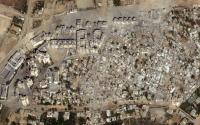6 February 2007Clifford Coonan
Wang Enming pauses as he emerges from the subway in Dongtan to listen to the sound of flocks of birds settling on the wetlands near the metro station, undisturbed by man as they prepare for a winter migration. Cycling the remaining three minutes home to his apartment, he marvels again at the fresh breeze coming off the mighty Yangtze river, which is never cleaner than at this point at the world's first eco-city near Shanghai.
The power that opens the door to his apartment comes from a solar cell on the roof, while the water he uses for his evening shower is recycled, as is all waste in this city of half a million residents. His dinner of boiled rice, spinach and spicy chicken has all been locally produced using organic methods. Later, he'll stroll down to the car club and rent a battery-powered sports car and whizz through the tunnel back to Shanghai to cruise the Bund. This is one possible vision of China in 25 years' time, low carbon-footprint living in the eco-city of the future.
Grim apocalyptic nightmares tend to characterise the usual environmental reports from China, but that is about to change as British engineers prepare to turn this vision of Dongtan into a reality. By 2030, 60 per cent of the world's population will be urban dwellers, and environmentalists insist that a radical programme of making our cities greener places to live is the only sustainable way to allow us to keep living in cities.
The good news is that in Dongtan, on Chongming island near Shanghai, half a million people will live in a car-free, zero-emission, recycling city with an ecological footprint one-third that of people in Shanghai. Environmentally sustainable city living is possible, its planners say, and is within our grasp. The Dongtan project could be the solution to the demands of city-living - combining the need to be environmentally sustainable with being extremely cool. The Mayor of London Ken Livingstone is reportedly interested in Dongtan as a possible blueprint for development in London.
This is the biggest single building project in the world, and it's taking place in a country many see as the biggest risk to the planet's green future. The urbanisation process in China is astonishing - there are already 90 cities with more than a million residents, and 400 million people are expected to move from the countryside to cities in the next 30 years.
The project has been given initial approval by the central government in Beijing and the remaining permissions are expected after Chinese new year later this month.
The initial phase will be finished by 2010, when the Expo fair comes to Shanghai, and it is forecast that by 2030 there will be more than 500,000 people living here. The project won't be cheap. The initial phase will cost around £1.5bn, but the figures are expected to rise into the double-digit billions. But it's an optimistic signal from China that the world's factory is serious about doing something on global warming and sustainability.
The British engineering group Arup, which built the Sydney Opera House, the Pompidou Centre in Paris and the Tate Modern in London, is working as a strategic partner with Shanghai Industrial Investment Corporation (SIIC) on the integrated master-planning for Dongtan. The planners describe Dongtan as a "holistic, systemic view of a city", a view of the world they say is vital to the survival of cities.
Three-quarters of the size of Manhattan and located on China's third largest island, Dongtan will be developed on 630 hectares of land to attract a range of commercial and leisure investments, mostly the kind of companies that can benefit from an ecologically positive environment, such as bio-tech companies. All the buildings in Dongtan will be self-sufficient in their energy use, with power coming from a combination of wind power, solar power and other renewable sources. All the apartments and houses will be within seven minutes' walk of public transport. Most of the citizens of Dongtan will work within the city and all buildings, made of local materials, will use a combination of traditional and new construction technologies.
Farmers on the island will be encouraged to use organic methods to grow the crops that will make the city self-sufficient in food. Battery and fuel cell-powered cars will whirr silently through its precincts.
The Arup engineers working on the project speak with real passion of the prospects for Dongtan. Many of them point out that it is their own children's future that is being secured with this kind of project. Dongtan will look like a science fiction movie, but the principles are tried and tested, said Peter Head, who is managing the project for Arup. Where Dongtan scores particularly highly is in its clever use of existing ideas. There is little to see on Chongming island yet, but given the dramatic changes on the Pudong district of Shanghai, which was transformed from being a sleepy, mosquito-infested wetland into a sleek, urbanised area of skyscrapers and monorails within a few decades, you know that anything is possible when urban planners have their minds set on something.
The island has grown over the past century because of silt deposited by the Yangtze, and further silt dumped in the river delta will be used to increase the available natural habitat for the millions of migrating birds that use the island as a stopping-off point. This adds an additional challenge to developing the island as much of it has been designated as a nature reserve. Mr Head said: "Because of the nearby wetlands and bird sanctuary, there will be no petrol or diesel cars, only fuel-cell or battery-powered cars. This means quiet vehicles, which means people can open their windows again and don't need to use air-conditioning."
President Hu Jintao gave his backing to the project during a visit to the Shanghai Urban Planning Exhibition in China's financial capital. The SIIC, which is controlled by the municipal government of Shanghai, is a powerful voice in urban renewal. Its brief has been to create a development with low-energy consumption that is as close to being carbon neutral as possible.
At the moment, you have to take a ferry to get to the island, but tunnels and bridges will join the island to Shanghai and then it will be 20 minutes away from the centre of Shanghai.
All cities are major energy users and you can't live in the city without electricity. It's hard to get by without a car. At the same time, the only way to deal with climate change is to address the rapid growth of cities. Mr Head said: "We're unravelling a whole series of self-inflicted problems which just seem to disappear. This gives people choices about how to live a low ecological-footprint lifestyle. Dongtan is not about a physical solution that can be copied, it's about a process that delivers, and a methodology we can apply in London or anywhere else."
Initially, some of Dongtan's residents will commute to Shanghai for work, but the goal is to provide employment for most of the island's residents. The planners hope that ultimately companies will choose Dongtan as a place to live and work.
Chris Luebkeman, who heads Arup's global foresight and innovation initiative, clearly sees the project as a potential saviour for our way of life on this planet. "Yes, we can save the world. If we want to," he said. "This project is a search for a way forward, a wish not to repeat what's happened in other cities." He is no naïve planner - he points out how China is building a coal power station a week - but he recognises how China, like every other country, will run out of fossil fuels if something is not done.
Urban areas will make up about 40 per cent of the land area of Dongtan, and one of the key aspects of the city's design will be preventing light and noise pollution, as well as emissions and water discharge reaching adjacent wetland areas. Canals, lakes and marinas will run through the city, with solar-powered water taxis. Visitors will park their cars outside the city and use public transport to get around inside the city. "This is about China trying to curb inappropriate demand, to modify demand into a more efficient utilisation of the resource," said Mr Luebkeman.
Mr Head added: "This is about reducing the footprint of life, about why we buy and why we consume. I can see a fashion developing in improving energy use, in having a higher quality of life with walking and cycling."
http://news.independent.co.uk/environment/article2241450.ece






